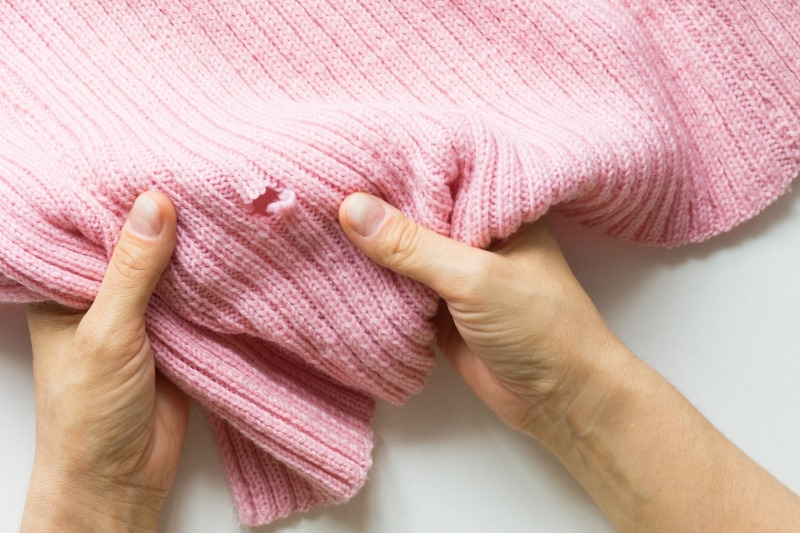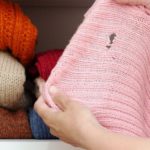We love our woollen jumpers, silk scarves and cashmere cardigans. They’re super comfortable, easy to wear and usually last a long time.
That is until a protein-loving clothes eater comes along and starts to chew tiny holes in our often-expensive clothes.
Moth larvae love nothing more than to feast upon soiled, natural fibred clothes in dark wardrobes.
By the end of their little chewing spree, the clothes usually end up resembling a sieve rather than a wearable garment! It’s just not a very nice experience to find your items covered in moth holes.
But what are you supposed to do about this infestation? If it carries on too long, a whole load of clothes could end up ruined beyond repair!
Keep on reading to discover what you need to do if you’ve got an army of moths in your wardrobe.
Do Moths Actually Eat Clothes?
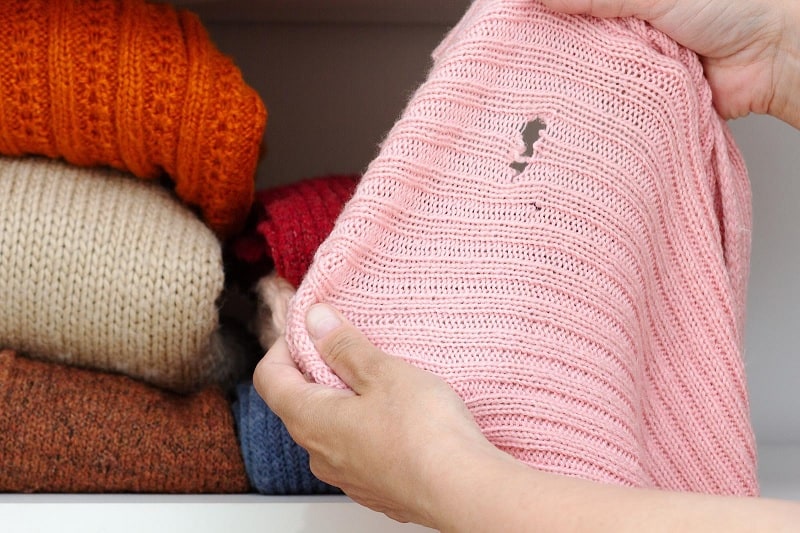
Technically speaking, adult moths don’t eat clothes. It is, in fact, their babies that eat the protein-rich garments in your wardrobe.
Moth babies are known as larvae and look like tiny cream-coloured worms. They like to feast on materials like silk, feathers, wool, fur, leather and cashmere because they want to consume keratin.
In addition to this, moth larvae are also attracted to debris that’s left on clothes like food, bodily oils and sweat.
So, if you pack away an item of clothing made from a material listed above that’s dirty, be prepared for a moth-related problem, because you’re giving them exactly what they want.
Wardrobes are good homes for baby moths as they’re usually dark, cluttered and cosy, and come with an ample supply of food.
Interestingly, there are over 2,500 species of moth recorded in the British Isles, but it’s only the case-bearing clothes moth (tinea pellionella) and the webbing clothes moth or common clothes moth (tineola bisselliella) that damage clothes and textiles.
So, be sure you’ve actually got the right kind of clothes-eating moth before you spend time and money treating the issue.
There’s a chance that you’ve seen a random moth flying about and it isn’t actually eating your clothes. In this case, the holes in your clothes could be caused by something else.
How Do You Know if You’ve Got Clothes Moths?
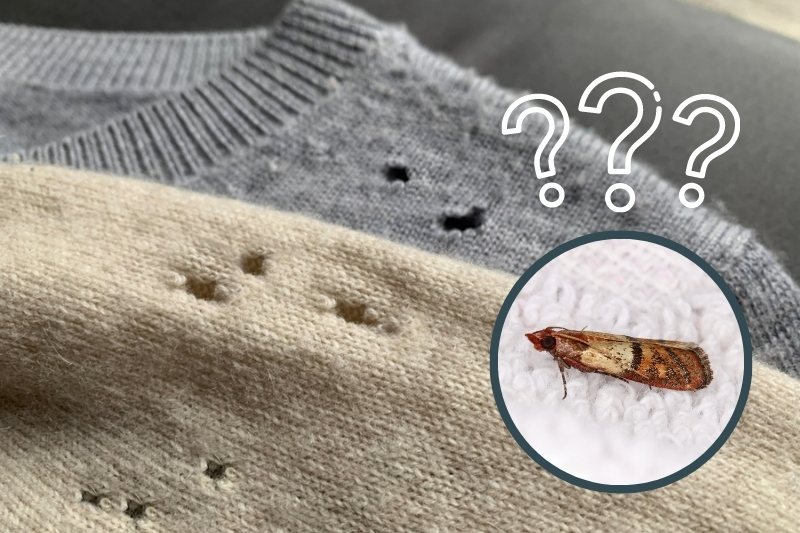
If you’ve found a few holes in your clothes but you’re not sure if you have an actual moth-related problem, keep an eye out for these signs:
- Seeing moths on your clothes – You may be able to hear and see an adult male moth flying around in your wardrobe. If this is the case you know that you must treat the issue before it gets worse. Adults are usually under 1 cm in length and are yellow/grey/shiny in colour.
- Damaged patches – You’ll notice damaged patches on your clothes, particularly on the front and sleeve areas. These sections are where we are most likely to drop food on ourselves or where sweat will have gathered. The larvae would probably say that these areas are the tastiest zones!
- Webbing in the wardrobe – You might be able to see some webbing in the corners of your wardrobe.
- Musty smell – There’ll be a musty smell coming out of the wardrobe and the clothes inside may be a tad whiffy too.
- Larvae on clothing – If you time it right, you may spot some larvae on your clothing.
- Dark, poorly ventilated wardrobe – Look at your wardrobe and ask yourself ‘Is this the perfect nesting ground for moths?’ – Is the wardrobe dark, humid, filled with dirty clothes, cluttered and poorly ventilated? If the wardrobe is in poor condition, you should remove the clutter and clean the spaces immediately because it’s the perfect breeding ground for moths.
If you see any of the signs above, you should investigate the problem further and then proceed to treating the issues accordingly.
Keep on reading to find out what you need to do about your moth problem.
How to Get Rid of Moths to Protect Clothes
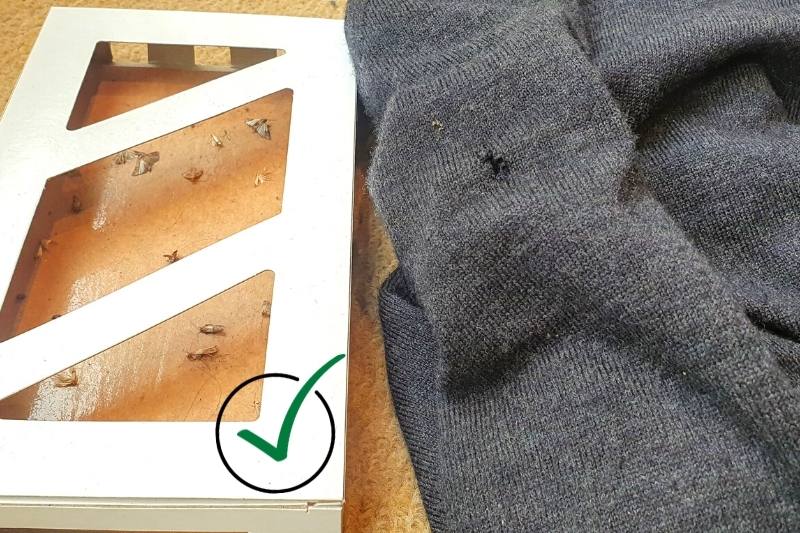
When you’re trying to get rid of moths it’s imperative that you remember to get rid of the larvae, and you need to prevent reproduction amongst the moths, so they cannot lay more eggs.
Follow the steps below to get moths out of your home and to protect your clothes.
1. Clear your wardrobe of clutter
- Remove everything from the wardrobe.
- Check clothes for holes.
- Throw out extremely damaged clothes and repair items that can be saved.
- Now is also a good time to start decluttering your wardrobe. Throw out what you don’t need and store the important items in the correct manner.
2. Clean the wardrobe
- Hoover the wardrobe once every item has been taken out (clean out the crevices and corners).
- Take out the hoover bag/empty the waste bin and dispose of the contents outdoors in a bin (remember that the larvae will be in the bag/amongst the dust).
- Clean the wardrobe with a moth killer spray, like Aviro Moth Killer Spray, or wipe it down with a white vinegar and water solution (one part vinegar to three parts water).
- If you use a specialised product, test the product first to check it doesn’t mark the wardrobe, and follow the guidelines on the packaging on how to use the solution.
Tip: Some specialised solutions advise you to reuse the product multiple times to make sure that you don’t get a re-infestation.
3. Brush clothing outside to get rid of eggs
Start brushing each item of clothing with a clothes brush outside, so you remove any moth debris before the items get washed.
Make sure you do this away from the house, so the eggs and larvae don’t get carried back into your home.
3. Wash all clothes in an appropriate manner
You’ll need to wash all of the clothes that have been in the wardrobe thoroughly. This will wash away any dirt, moth residue and larvae from the items.
You should then leave the clothes in sunlight to dry. Keep any eye on delicate materials as the sun’s rays may damage them.
4. Freeze your clothes for 72 hours in moth proof bags
If you have room in your freezer, you could pop your clothes into sealable bags and freeze them. Moths don’t like the freezing temperature, so this is another way of making sure they’re completely gone.
5. Repair damaged clothes
Once your clothes are clean and free from moths, you can start to repair them. Not all clothes will be repairable, but perhaps you could repurpose the material and create something else.
For tips on how to mend clothes, keep on reading.
6. Place moth deterrents in the wardrobe

Once you’ve cleaned away the moths you don’t want them to return. So, before you add your clothes back into the wardrobe, pop some deterrents in the space to keep the moths at bay.
Pheromone traps like London Moth Pheromone Moth Killer are designed to trap male moths and thereby limit moth reproduction in the wardrobe.
These traps are easy to use too. You just pull off the protective sticky tape, reveal the sticky surface that will trap the moths, bend the trap into a triangle and hang it up in the wardrobe.
They’re very cost effective, user-friendly and last up to three months. So, they’re ideal for catching the little moths that managed to get away during your cleaning phase!
You can also use lavender fragrance hangers, like Aviro Moth Killer Hangers. Moths don’t like the smell of lavender, so it keeps them at bay. The lavender vapour that comes off the hangers also makes your wardrobe and clothes smell, and makes the environment and the materials even less appetising to the moths.
7. Store clothes properly
If your wardrobe is full of natural fibred materials, you need to store them in airtight bags in the wardrobe. This will protect the clothing from potential moth larvae.
8. Add clothes back into the wardrobe
Once you’re all set, you can put your clothes back into the wardrobe. But don’t pack all your stuff in really tight, leave plenty of room for air to flow around.
9. Check the house for any evidence of moths
Have a look around your home to make sure you didn’t drop any debris as you were cleaning the moth infestation away. If you do see something, treat the area, so the moths don’t start sprouting up again.
10. Get professional help if necessary
If you’ve tried the steps above and you’re still having problems, it’s time to call in a professional pest management team.
A professional team is normally trained to deal with such infestations, and they’ll have different tools to help remove the pesky moths from your home once and for all.
In addition to the above, a professional should be able to advise you on how to prevent a re-infestation of moths in your home.
An online search will tell you where the nearest service is. Just remember to do your research into the company, find out what products they will use and what impact this will have on you/your home/furniture, and make sure you know how much the work will cost before signing any contracts.
How to Prevent a Moth Infestation

Nobody wants moths in their home, so rather than having to deal with the infestation after it happens, you should try and prevent it from happening in the first place.
You can do this in multiple ways, but the end goal is to make your wardrobe as uninviting as possible for the moths!
Here are some tips to help you keep moths and their larvae at bay:
1. Maintain and clean the wardrobe
The dirtier the wardrobe, the more homely it is for the moths. So, if you make a habit of removing all your clothes, cleaning them, and hoovering and wiping down the insides of your wardrobe on a regular basis, the space won’t be as inviting for the moths.
In turn, they probably won’t want to live there!
2. Keep an eye on the space
If you keep an eye on your wardrobe, you’ll be able to spot the first signs of any problems. If you do see an issue occurring, you can sort it out as soon as possible. This way you can prevent the problem from escalating.
3. Store clothes appropriately
Moth larvae love materials made from natural fibres, so if you’ve got a lot of silk, wool and fur in your wardrobes, you’ve got to take some extra steps to care and maintain these garments properly. You could store the items in airtight bags, for example.
4. Open the wardrobe door often
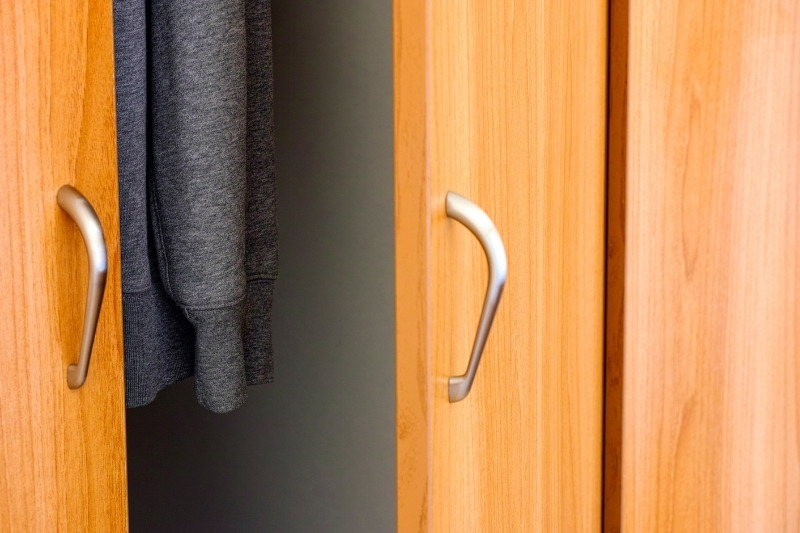
It’s worth leaving your wardrobe doors open on a regular basis so clean air can go into the space, and humid air that’s trapped inside can be released.
Moths and their larvae love humid spots, so by allowing cool air into the space, it instantly becomes less inviting for them.
Fresh air can do the world of good, so leave the doors open when the bedroom isn’t in use! You could do this every single day.
5. Move clothes around
If you constantly swap, pull out and change your clothes around in your wardrobe, you’ll create a more hectic and less habitable environment for the moths. The constant change isn’t exactly welcoming!
6. Clean clothes before storing them
Moth larvae love to feast on natural fibres, old food, bodily fluids and oils, so make sure you clean your clothes before storing them.
Pay particular attention to materials that you know the larvae will want to dine on anyway—your silks, cashmeres and leathers, for example.
The tiny larvae are already interested in these fabrics, so don’t make the material even tastier by storing them in a dirty state in the wardrobe.
7. Let light enter the wardrobe
Leave plenty of natural light into the wardrobe because the moths like dark spaces.
8. Shake out clothes you bring home
If you’ve been given clothes, or you’ve picked up a bargain at a charity or vintage shop, you should make a habit of shaking, treating and washing the clothes before you store the items in your wardrobe.
Sadly, you don’t know what germs and bugs could be living on these garments, so it’s better to get rid of them before they contaminate your other clean clothes.
9. Keep your wardrobe ventilated and don’t pack clothes in tight
Try and make a habit of keeping your wardrobe well ventilated and as decluttered as possible. Tight, dark spaces, where very little light or air can circulate are ideal spots for moths to set up home.
So, keep your wardrobe relatively clear and, in turn, air will be able to circulate freely inside.
How to Mend Moth Holes
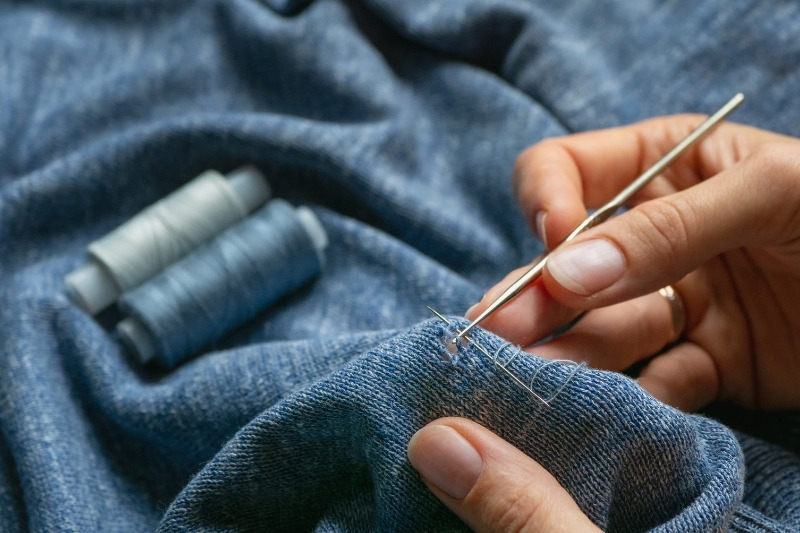
If the larvae have gnawed away at your clothes, but you can’t bear to part with any of your items, you could always try and repair the goods. Even the garments that look more bin-worthy than wear-worthy can be saved. You could even put your own design spin on the item!
There are multiple ways you can fix your hole-ridden clothes! Check out the methods below, and don’t worry if you don’t fix your clothes right first time; it takes practice.
1. Darning
Darning is an old sewing technique that’s used to repair clothes that have holes in them. You typically place a mushroom looking object under the hole, and then you use a needle and thread to close up the gap.
2. Needle felting
If you’ve got a holey jumper, you could try felting up the gap! When you bond wool together you get a really strong finished effect.
3. The no sew method
If you’ve got lots of tiny holes to deal with, but parting with your much-loved item of clothing is a no-go, you can try this quick and simple, no sewing needed method, to mend your item.

Bethan has a passion for exploring, reading, cooking and gardening! When she’s not creating culinary delights for her family, she’s concocting potions to keep her house clean!
